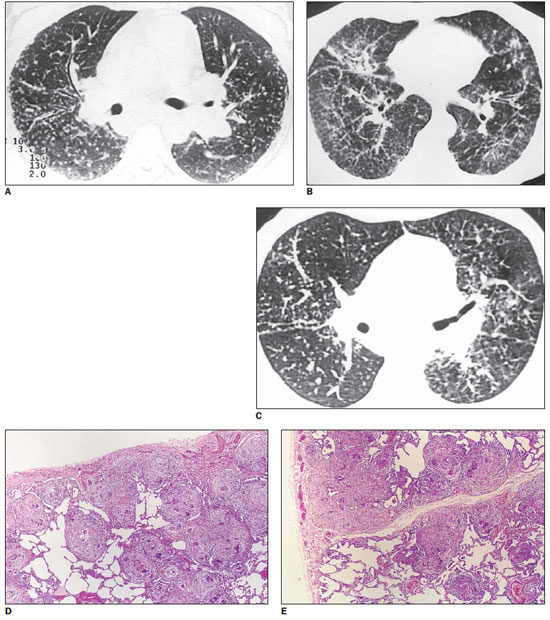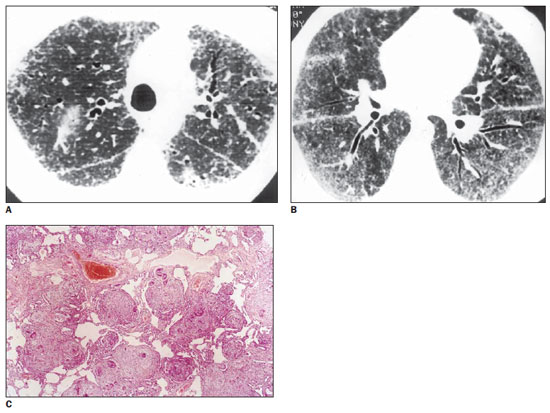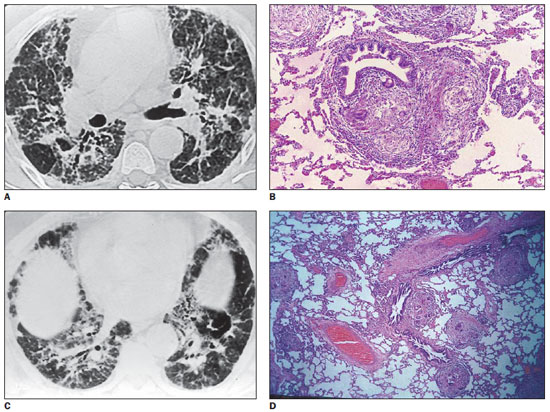INTRODUCTION
Sarcoidosis is a multisystem disease of unknown etiology, characterized by the presence of noncaseating granulomas, affecting many tissues and organs in the body, particularly the respiratory tract(1).
Although in most of cases this disease is typically self-limited, running its course towards cure or stabilization without the use of immunosuppressant drugs or anti-inflammatory agents, irreversible and extensive pulmonary fibrosis may develop, leading to a progressive deterioration of the respiratory function(1).
An understanding of the normal anatomy as well as of the changes caused by the disease is required for an appropriate analysis of any radiological image, and radiologic-pathologic correlation is critical to understand the anatomical foundations of images formation(2).
Many studies have described the findings of sarcoidosis at computed tomography; but only a small number of them have correlated high-resolution computed tomography (HRCT) findings with pathological findings(2—4). Many times, such a correlation is hardly established, considering that the patients who die are generally those with extensive fibrotic lesions in the lungs, and open biopsy is rarely performed in cases o sarcoidosis(5).
The present study discusses the main findings observed at HRCT in sarcoidosis, correlating them with pathological findings.
MATERIALS AND METHODS
The present study reviewed HRCT findings in ten patients of hospitals in Rio de Janeiro, RJ, Brazil, with histologically confirmed diagnosis of sarcoidosis. Such radiological findings were correlated with those observed in specimens obtained from surgical biopsies or at necropsies of four of such patients. The age range was between 30 and 68 years (mean = 48 years), and the study sample included seven female and three male patients.
RESULTS
Presence of nodules with perilymphatic distribution was the most frequent finding. The lesions were predominantly observed along bronchovascular sheaths and pleural surface, with subpleural nodules and nodular scissurae (Figure 1). Interlobular septal thickening was a less frequent finding. Ground-glass opacity was another less frequent finding, generally observed in association with the presence of small nodules (Figure 2). In general, all these findings correlated pathologically with accumulation of granulomas in those regions. Air trapping was other interesting finding determined by bronchial lumen narrowing caused by the presence of peribronchial granulomas (Figure 3).

Figure 1. Three different patients. On A and B, presence of bronchovascular sheaths thickening and clustered nodules in the subpleural region. On B and C, nodular scissurae are also highlighted. On A, observe hilar lymph nodes enlargement, and on C, vessels with apparently increased caliber, particularly at right, determined by perivascular sheath thickening. On D and E, histological sections demonstrate clustered granulomas in the subpleural region (D) and along the interlobular septum (E), responsible for the nodular appearance of such structures at HRCT.

Figure 2. On A and B, HRCT demonstrating ground-glass opacity, with finding of diffuse micronodules and nodular scissure. Also, note irregular thickening of peribronchovascular sheaths. On C, histological section demonstrating that ground-glass opacities were due to the presence of sparsely distributed parenchymal granulomas compressing alveolar spaces.

Figure 3. On A, HRCT demonstrating inflated secondary pulmonary lobule in the right lower lobe, besides thickened septa with evidences of fibrosis. On B, section demonstrating granuloma compressing bronchiole and determining air trapping. On C, HRCT showing inflated pulmonary lobule at the bottom of the left lung, with a centrilobular arcade-like structure and nodular contour. On D, centrilobular region section showing multiple granulomas in the peribronchovascular sheath, determining narrowing of the bronchiole lumen, explaining the valve emphysema and the arcade-like configuration with nodulations observed on C.
In sarcoidosis, granuloma is the basic histopathological finding. Noncaseating granulomas are confined to the interstitial compartment of the lungs, with a perilymphatic distribution along bronchovascular sheaths, interlobular septa and pleural surface(4,6,7), including the scissural pleura(7). Such a preference for peribronchovascular regions explains the high frequency of positive transbronchial biopsies(8). In general, predominant sites of lesions are the upper, middle and posterior zoned os the lungs(8). In truth, granulomas may determine three image patterns: nodules, irregular thickening of structures and ground-glass opacity(2). Areas of consolidation may also be observed as a result from irregular confluence of nodules(8).
Nodules represent the most frequent findings at HRCT(7). In general, they have 2 to 10 mm in diameter, irregular margins(3,7), histologically representing granulomatous aggregates(3,6,7).
Less frequently, granulomatous aggregates may originate large nodules (> 1 cm) and large areas of opacity with ill-defined contours(2,3,5,7,8).
Small, individual granulomas sparsely distributed over the parenchyma produce ground-glass opacity(7). Such granulomas are not sufficiently large to be individualized at HRCT, but produce a diffuse increase in lung attenuation originating this image pattern(6). Initially, some authors suggested that such a pattern was related to alveolitis, but later studies have demonstrated that, as a rule in acute phases of sarcoidosis, this pattern was determined only by the presence of granulomas(2,3,7). Although ground-glass opacity usually corresponds to the presence of a potentially treatable or reversible disease, in some cases it results from fibrosis(1,7). The presence of fibrosis is suggested by concomitance of traction bronchiectasis, bronchiolectasis and parenchymal distortion(1).
In spite of their perilymphatic distribution, a higher number of sarcoid granulomas occur along bronchovascular sheaths and in lower number, in interlobular septa and subpleural regions(3). Interlobular septal thickening is a less frequent finding in sarcoidosis(7,9).
Linear opacities are less frequent and less profuse than nodules. Polygonal arcades such as those observed in carcinomatous lymphangitis, are extremely rare findings in sarcoidosis(7,9). In sarcoidosis, nodules present irregular margins; in lymphangitis, they are generally smoother(9). Sometimes, the lymphatic distribution is histologically difficult to recognize, because of the disproportionate involvement of an anatomical site as compared with another. In sarcoidosis, there is a much greater involvement of bronchovascular sheaths, and little involvement of septa and pleural surface, eventually suggesting a bronchiolocentric/angiocentric pattern rather than properly a lymphatic pattern(4).
Proliferation of granulomas along bronchovascular sheaths causes their irregular thickening(3), with arterial walls and bronchi appearing like “rosary beads” because of their contour nodularity(7). Also, scissurae and interlobular septa may present such “rosary beads” pattern(7).
At HRCT, the pleural surface may present a nodular pattern; pleural granulomas cannot be differentiated from those located in alveolar septa adjacent to the pleura(3).
It is important to recognize that the presence of cellular and granulomatous inflammatory elements indicates disease activity, reversibility and favorable response to treatment, while fibrotic involvement indicates disease irreversibility and poor therapeutic response(1).
In general, alterations determined by granulomas (small nodules, large nodules, ground-glass opacity and nodular thickening — “rosary beads” pattern — of interstitial structures) are reversible(3,5), since they represent active inflammatory lesions(5). Either with or without treatment, such lesions may persist for months or years, or otherwise be reabsorbed(1,8).
However some findings are irreversible, representing manifestation of fibrosis. A common sign observed in cases of fibrosis is architectural distortion that may cause posterior ballottement of the main bronchus or of the upper bronchioles(5,7,8). Other findings include traction bronchiectasis, honeycombing(5,7,8), cysts and bullae(7), and parenchymal bands, septal and non-septal lines(5). Irreversible, linear, irregular and elongated opacities may appear, particularly along bronchovascular sheaths as an early manifestation of fibrosis(7). Irregular interfaces similar to those observed in idiopathic pulmonary fibrosis, have also been described, determined by focal septal fibrosis(8). The fibrosis may be so extensive as to form perihilar masses resembling the progressive massive fibrosis of silicosis(7). Other possibility is the post-treatment persistence of ground-glass opacity, attributed to alveolar septal fibrosis(5).
As regards pulmonary function, studies have demonstrated that the profusion of granulomas observed in biopsies is not correlated with functional deterioration(1). Apparently, the functional alteration, rather than the quantity of lesions, is related to the strategic location of some granulomas (involving bronchioles and causing increased resistance to air flow)(1,6). Airways narrowing determined by peribronchial granulomas results in air trapping at HRCT, particularly in studies performed during the expiratory phase, where the crazy-paving pattern can be seen(6).
REFERENCES
1. Remy-Jardin M, Giraud F, Remy J, et al. Pulmonary sarcoidosis: role of CT in the evaluation of disease activity and functional impairment and in prognosis assessment. Radiology. 1994;191:675-80.
2. Müller NL, Miller RR. Ground-glass attenuation, nodules, alveolitis, and sarcoid granulomas. Radiology. 1993;189:31-2.
3. Nishimura K, Itoh H, Kitaichi M, et al. Pulmonary sarcoidosis: correlation of CT and histopathologic findings. Radiology. 1993;189:105-9.
4. Colby TV, Swensen SJ. Anatomic distribution and histopathologic patterns in diffuse lung disease: correlation with HRCT. J Thorac Imaging. 1996;11:1-26.
5. Brauner MW, Lenoir S, Grenier P, et al. Pulmonary sarcoidosis: CT assessment of lesion reversibility. Radiology. 1992;182:349-54.
6. Gleeson FV, Traill ZC, Hansell DM. Evidence on expiratory CT scans of small-airway obstruction in sarcoidosis. AJR Am J Roentgenol. 1996;166:1052-4.
7. Traill ZC, Maskell GF, Gleeson FV. High-resolution CT findings of pulmonary sarcoidosis. AJR Am J Roentgenol. 1997;168:1557-60.
8. Brauner MW, Grenier P, Mompoint D, et al. Pulmonary sarcoidosis: evaluation with high-resolution CT. Radiology. 1989;172:467-71.
9. Müller NL, Kullnig P, Miller RR. The CT findings of pulmonary sarcoidosis: analysis of 25 patients. AJR Am J Roentgenol. 1989;152:1179-82.
1. Associate Professor, Department of Radiology, Universidade Federal Fluminense (UFF), Niterói, RJ, Brazil.
2. Titular Professor, Department of Radiology, Universidade Federal Fluminense (UFF), Niterói, RJ, Adjunct Coordinator of Post-Graduation Course in Radiology, Universidade Federal do Rio de Janeiro (UFRJ), Rio de Janeiro, RJ, Brazil.
3. Assistant Professor of Pneumology, Universidade do Estado do Rio de Janeiro (UERJ), Rio de Janeiro, RJ, Brazil.
Mailing Address:
Dr. Edson Marchiori
Rua Thomaz Cameron, 438, Valparaíso
Petrópolis, RJ, Brazil, 25685-120
E-mail: edmarchiori@gmail.com
Received March 17, 2011.
Accepted after revision May 20, 2011.
Study developed at Department of Radiology, Universidade Federal Fluminense (UFF), Niterói, RJ, and at Unit of Radiodiagnosis, Hospital Universitário Clementino Fraga Filho (HUCFF) da Universidade Federal do Rio de Janeiro (UFRJ), Rio de Janeiro, RJ, Brazil.
 Vol. 44 nº 4 - July / Aug. of 2011
Vol. 44 nº 4 - July / Aug. of 2011


